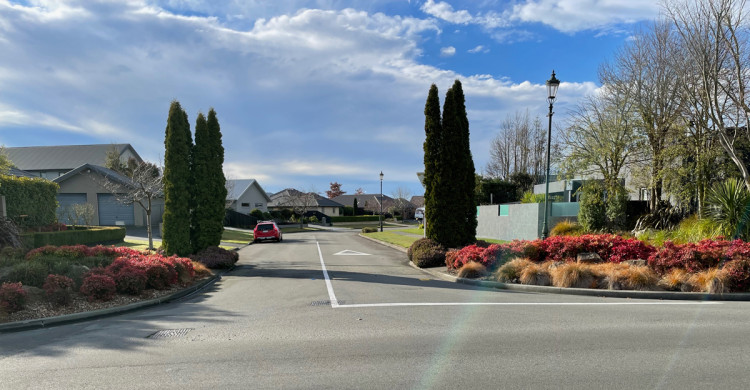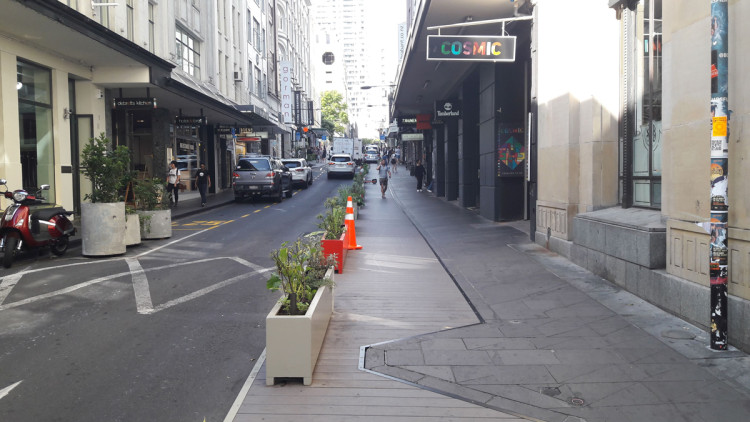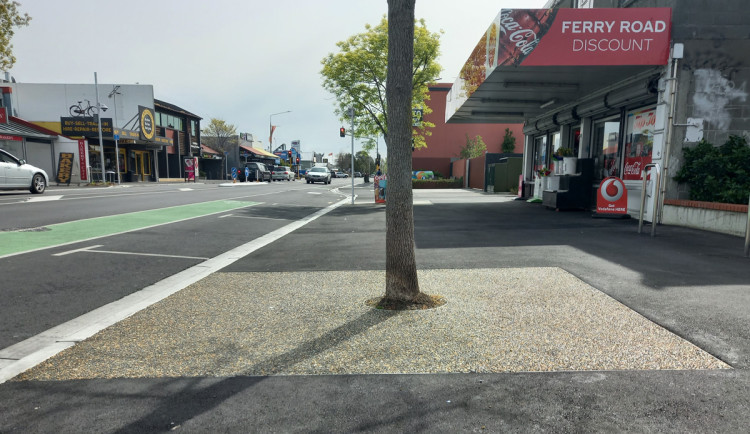Landscape treatments contribute to a pedestrian environment and have the following benefits:

Large street trees create shade and an attractive streetscape, Nelson. (Photo: Jeanette Ward)
Permanent planting should primarily be sited within the street furniture zone. Species should be selected and located with care to ensure they fit in the surrounding area and are appropriate for the environment. It is particularly important in pedestrian areas to consider:
Crime Prevention through Environmental Design (CPTED), including that the landscaping does not create cover for criminal or antisocial activities. Landscape treatments should be designed, placed and maintained in accordance with CPTED principles.
The photo below shows vegetation that is starting to protrude over the footpath through route.

Vegetation starting to protrude over the pedestrian through route. (Photo: Jeanette Ward)
The photo below illustrates that the choice of tree species and maintenance programme can significantly impact on the space available for pedestrians and can also create CPTED issues if visibility along the path becomes restricted.

Street tree that has not been trimmed adequately to maintain footpath through width, Auckland. (Photo: Jeanette Ward)
See Waka Kotahi NZ Transport Agency’s Landscape Guidelines for landscape planning, design and management considerations and the Aotearoa Urban Street Planning and Design Guide for general advice on integrating landscaping within the built environment.
Waka Kotahi NZ Transport Agency Landscape Guidelines
Aotearoa Urban Street Planning and Design Guide

Permeable pavers were used to protect the tree roots but also provide an easily maintained smooth surface for path users, Linwood Avenue Christchurch. (Photo: Jeanette Ward)

Landscaping used to separate bus stop access path, two-way cycleway, and footpath, Quay Street Auckland. (Photo: John Lieswyn)
It is important that plantings and tree limbs do not block intervisibility between pedestrians, drivers and other road users particularly where pedestrians cross a street.
The figures below show how landscaping can help ‘frame’ streets and create a lower speed environment. The first figure shows how large vertical landscaping is omitted on one side because drivers and pedestrians need to be able to see each other, and drivers are not otherwise impeded along this street section. The second figure shows a potential intervisibility risk at a crossing point. However, drivers are turning at a low speed at this location.

Landscaping frames a suburban street and vertical element (the trees) are omitted where intervisibility is critical, Rangiora. (Photo: John Lieswyn)

Landscaping frames a suburban side street but creates an intervisibility issue at crossing point, Rangiora. (Photo: John Lieswyn)
Moveable planters can be placed in the frontage zone (or street furniture zone in a traffic calmed area) as long as they do not protrude into the through pedestrian route. Footpath zones are described in the footpaths section.
PNG: Footpath design – principles
For design purposes planters should be considered as street furniture. They may also be used to delineate space such as temporary footpaths or cycle lanes. See the Waka Kotahi Tactical Urbanism Handbook and Design Guidance Note.
A key aspect of temporary planters is that they must have sufficient soil volume to retain moisture for the flora they contain, given local weather conditions and watering regimes.

Moveable planters in street furniture zone, Palmerston North. (Photo: Jeanette Ward)

Temporary planter boxes used as separation and amenity elements in a pilot footpath widening project, High Street Auckland. (Photo: Jeanette Ward)
See Case Study: High Street, Auckland(external link)
Green infrastructure is increasingly an integral part of sustainable, ‘green’ street design. The layout of these elements should recognise pedestrian desire lines and the through pedestrian route, as well as detailing to prevent trips and falls.
As an example, rain gardens are designed and constructed to capture and treat stormwater runoff through sedimentation, filtration, infiltration, adsorption, and biological processes[1]. Like other landscape treatments, they can be utilised to support better pedestrian environments by preventing illegal parking and minimising pedestrian crossing distances.[2].
These elements can become a trip and fall hazard if not positioned, detailed, and maintained correctly. Stormwater or planting detention spaces should be designed and maintained to not create a trip or fall hazard for pedestrians.[3]. The depth should be minimised and steep slopes avoided. Several solutions are possible to minimise hazards:

Rubberised resin bound organic mulch paving provides a flush surface around trees, Ferry Road, Christchurch. (Photo: Jeanette Ward)

Good example: rain gardens with a recoverable shallow depth and well maintained plantings minimise the likelihood of tripping and falling, Wynyard Quarter. (Photo: John Lieswyn)

Poor example of a deep tree pit (>100mm drop) in a pedestrian path which may result in a rolled ankle or fall, Christchurch. (Photo: Ann-Marie Head)
[1] NZ Transport Agency (2010). Stormwater treatment standard for state highway infrastructure [PDF, 15 MB].
[2] [3] Cunningham, A., Colibaba, A., Hellberg, B., Silyn Roberts, G., Simcock, R. Speed, S., Vigar, N. and Woortman, W., (2017). Stormwater Management Devices in the Auckland Region(external link). Auckland Council guideline GD2017/001.